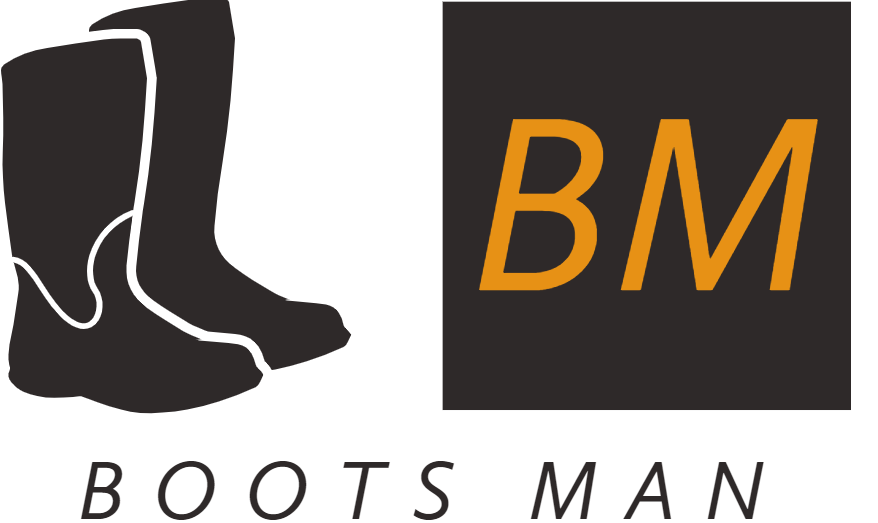Are you wondering how to select the right pair of slip-on work boots? You’re not alone! Choosing the right style and material is critical for any job that requires long periods of standing or walking.
This complete guide will help you choose the perfect pair for both comfort and safety.
Slip-on work boots can provide the much-needed safety, durability, and comfort when you’re working in a challenging environment. Choosing the right type of slip-on work boots is essential to ensure maximum protection as well as comfortable wear. Slip-on work boots come in various styles, shapes and materials which makes the selection process more complex.
This guide provides an overview of the different types of slip-on work boots available along with brief descriptions of their features and benefits. It explains why it is important to choose the right pair of work boots for your job, so you are safe and comfortable whilst on duty. In addition, this guide will provide handy tips on buying slip-on work boots for yourself that fit perfectly and last long.
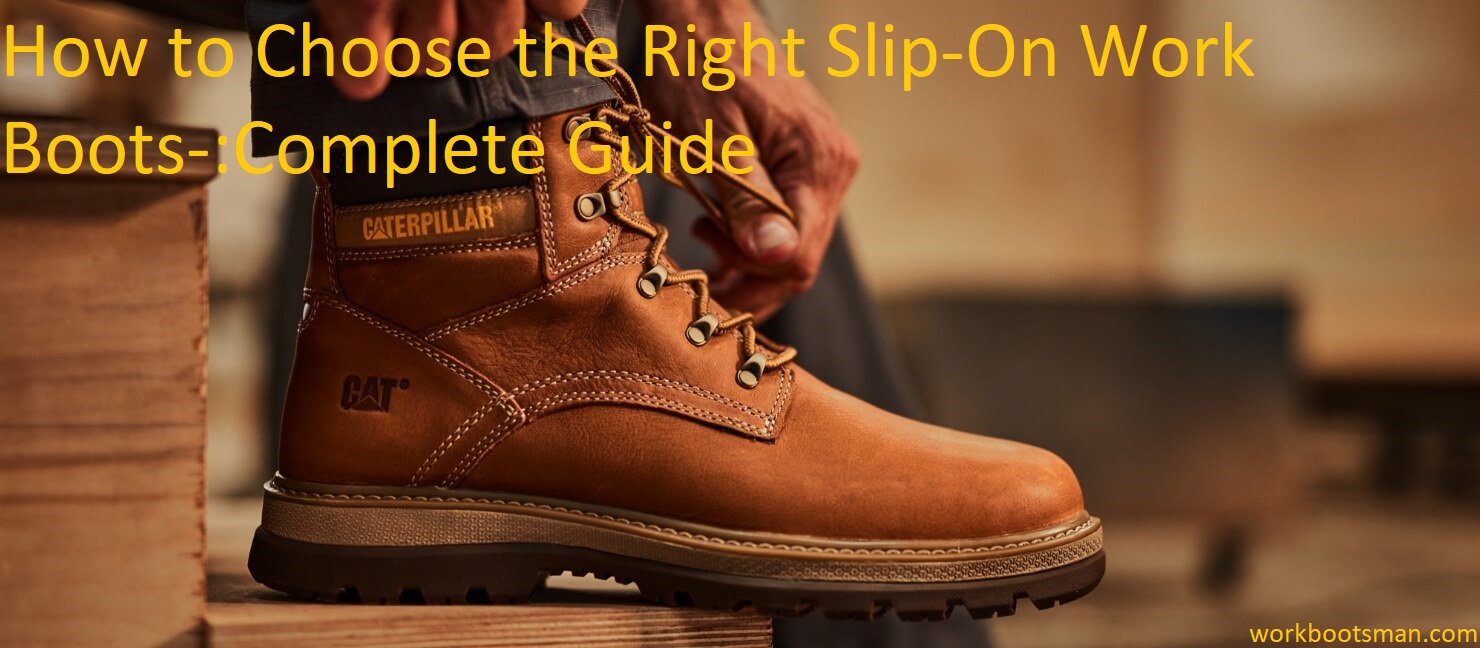
Definition of slip-on work boots
Slip-on work boots are designed to reduce the risk of slipping and offer a comfortable fit for the wearer. This type of footwear features an upper portion made from a variety of materials, such as leather, nubuck, or canvas. A traditional fit is usually coupled with laces that begin at the toe and loop around the ankle and up to a hook-and-loop clasps at the top.
The outsoles and midsoles are made from a hard rubber compound to provide slip resistance and shock absorption. Slip-on work boots are popular among tradespeople since they offer protection against sharp objects, as well as providing ergonomic comfort on tough terrains such as gravel or third rail tracks.
Importance of choosing the right slip-on work boots
The importance of selecting the right pair of slip-on work boots cannot be overstated. Not only do comfortable work boots keep your feet safe from injury and provide support during long days on your feet, but they are also made to endure tough job site conditions and last for many years. It is essential to choose slip-on work boots that provide adequate cushioning and support while still maintaining maximum mobility when you move on the job site. The right slip-on work boot should also have durable construction and excellent traction to ensure a safe grip on all types of surfaces, even when wet.
It is important to note that there are wide varieties of slip-on work boots available in the market today, ranging from traditional leather uppers to modern synthetic materials that provide increased protection. When selecting slip-on work boots you will need to consider the type of job or activity you will be undertaking so that you can select a pair with features which suits your needs best. Whether you are looking for rugged outdoor durability, lightweight breathability for light duty tasks, or something in between – having a good understanding of your needs can help make sure that you get the best pair of slip-on work boots for yourself.
Brief overview of the article
This article is a comprehensive guide to choosing the right slip-on work boots. Slip-on work boots are designed to be comfortable and protective, so it’s important that you choose the right pair to suit your needs.
This guide will provide information on the different types of slip-on work boots available, their benefits, and tips for selecting the best pair of slip-on boots for your particular working environment. From oil and gas riggers, construction workers, mechanics, contractors, and farming professionals – we provide detailed insight on how to choose slip-on work boots that offer the most benefit for each application.
We’ll also provide a list of features you should look for when selecting a pair of slip-on work boots as well as an overview of factors to consider when purchasing them.
Factors to consider when choosing slip-on work boots
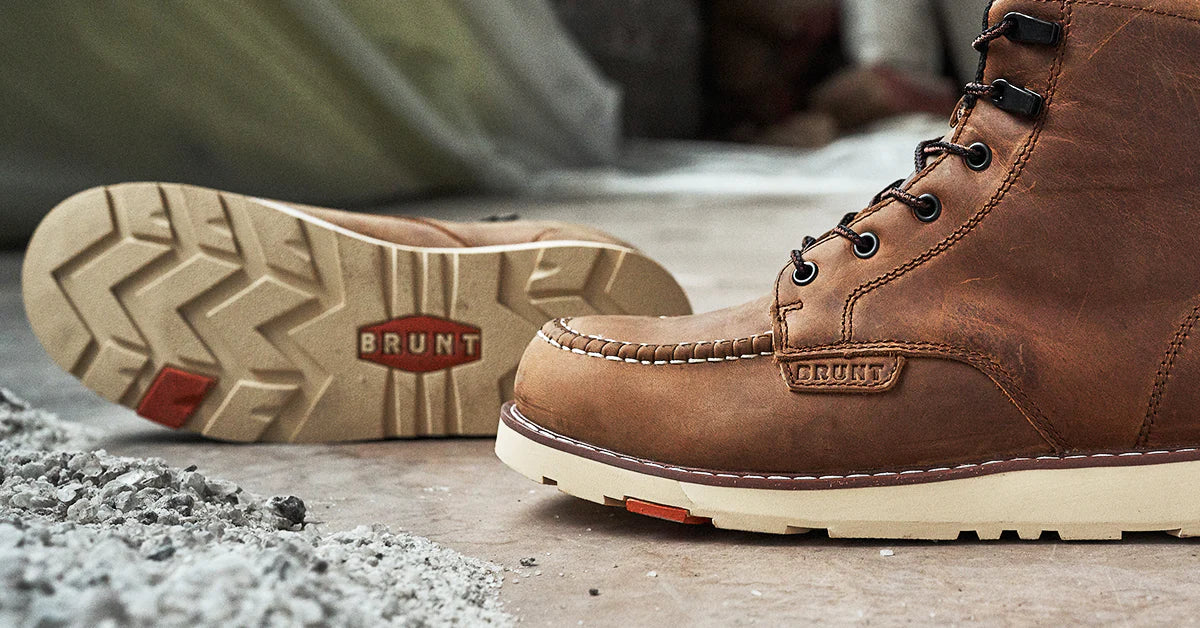
The right slip-on work boot can provide you with the comfort and protection that you need to do your job effectively. There are several key factors to consider when selecting a pair of slip-on boots, such as:
- Comfort – Comfort is one of the most important factors to consider when choosing slip-on work boots. You should make sure that the boots fit properly and offer adequate cushioning and support for your feet, ankles, and legs. Choose a quality insole that meets your needs and provide shock absorption for long days on the job.
- Durability – Slip-on work boots must be able to withstand wear and tear in order to deliver reliable performance over time. Look for a pair of leather or synthetic materials with breathable lining that is durable enough for extended use. Also, double check for reinforcements at the heel, toe, and sides of the boot which can help it last longer in tough conditions.
- Waterproofing – If you’re working outdoors in wet conditions, waterproofing needs to be top priority when looking at slip-on work boots—choose a pair with waterproof membranes or features treated with special water repellent coatings designed to keep out moisture while still providing breathability. A good sealant on any gussets will also help keep water out while allowing moisture to escape from around your foot as well as minimize blisters during long hours spent on your feet outdoors or even indoors where dampness is present due to rain or snow accumulation outside.
4 . Traction – For optimal safety, traction should also be an important factor when choosing a pair of slip-on work boots: Look for multi-directional lugs on the sole which will provide grip and better control on wintry surfaces or icy terrain; rubber outsoles featuring crampons may also be advantageous if you are working in areas prone to slippery conditions outdoors year round. Lastly take into consideration different surfaces such as tile ceramic, concrete, wood due less weight more grip.
Comfort
When it comes to slip-on work boots, comfort is key. It’s important to find a pair that fits properly and provides enough cushion and support for your feet, as well as protection from knocks, scrapes and moisture. Look for an anti-fatigue insole or supportive arch to ensure you have the best possible comfort level on the job.
Additionally, a good set of slip-on work boots should be outlined with padded linings that make it easier to get into and out of them throughout the day. The soles should be designed with shock absorption technology that provide comfortable cushioning while walking. With innovative designs like air sock technology, you can also get maximum breathability that will keep your feet cool all day long.
By considering materials such as rubber outsoles, leather uppers or mesh linings when choosing slip-on work boots they can offer maximum foot protection while keeping you dry in tough working environments.
Safety features
Slip-on work boots are a great choice for those who are looking for comfort and convenience. Choosing the right work boot can be daunting, so it’s important to make sure that you choose one with the right safety features. Here are some of the safety features you should look out for when buying slip-on work boots:
- Steel Toe Cap: If you’re working in hazardous conditions, steel toe caps are essential. Look out for slip-on work boots that have ASTM rated steel caps which guarantee maximum protection.
- Slip Resistant Materials: Slips and falls can be very dangerous while working, but slip-resistant materials like rubber soles will help ensure optimal safety on almost any surface. Choose a pair of slip-ons that combine traction and texture to guarantee stability underfoot.
- Heat Resistance: Working with molten material or near hot surfaces is part and parcel of many jobsrequiring protective footwear; The soles of your work boots should be heat resistant to make sure your feet stay safe in these environments.
Durability
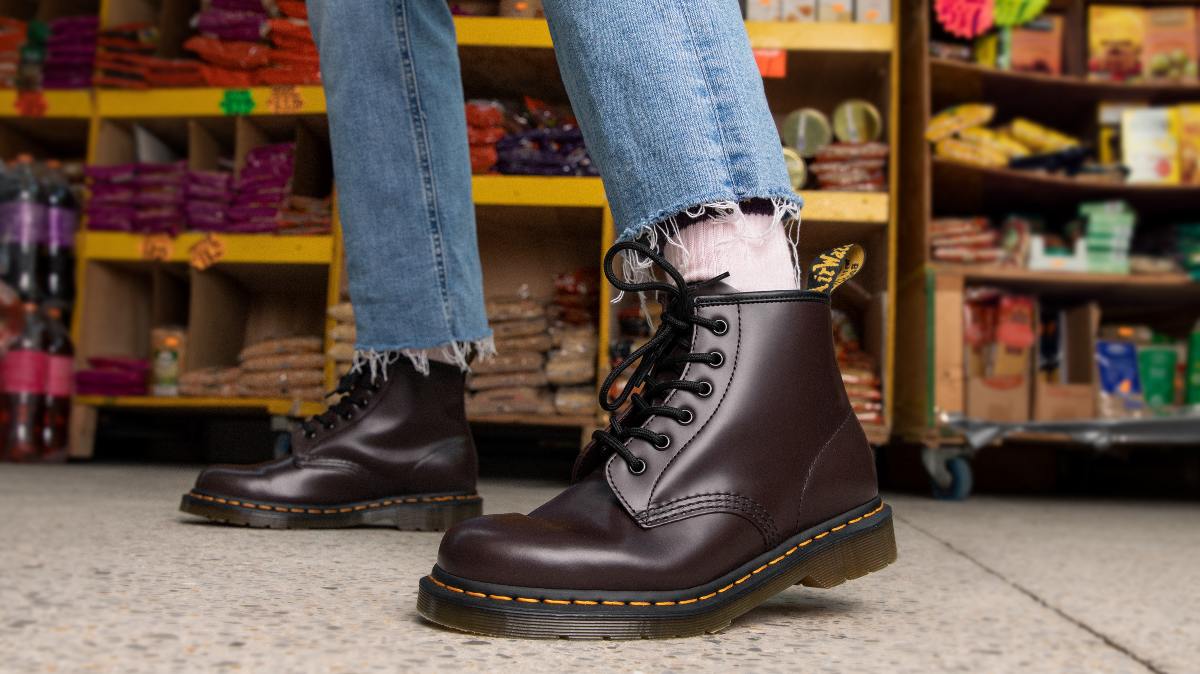
When you are looking for your perfect pair of slip-on work boots, one of the most important features to consider is durability. Durability can refer to the overall construction of the boot as well as the materials used in its construction. Quality leather is typically more durable than synthetic materials and can offer more protection against water and harsh weather conditions.
Make sure the sole of the work boot has good grip for slippery surfaces and shock absorption, since you’ll be spending long hours on your feet. Additionally, it should also provide good cushioning while allowing freedom of movement. The upper part of the boot should also provide firm support around your ankle and foot, to prevent any discomfort or potential injury while working.
Finally, proper seam work is essential for ensuring a longer lifespan for these boots – look for reinforced stitching at points of stress or friction to ensure maximum protection from wear-and-tear over time.
How to measure your feet for slip-on work boots
Measuring your feet for slip-on work boots is an important part of the process. It can help you to ensure a good fit and make sure that you select a boot that is comfortable, durable, and well-suited to your daily tasks.
The first step in measuring your feet is to place a tape measure or ruler on a flat, hard surface. You should be able to see the entire length of your foot when doing this. You can also place your foot on a piece of paper and trace its outline if necessary. Take note of the length and width (at its longest points) of each foot. Make sure that you also measure the circumference around both feet in case you need wide boots.
Once you have measured both feet, look for slip-on work boots that match or slightly exceed those measurements in terms of length and width. If there are significant differences between the measurements on each foot, consider getting slip-on work boots in two different sizes to give yourself relief if needed. When trying on new boots, keep note not just of the overall fit but also where any potential tightness or restrictions are (especially around areas like the arch and toe box).
Finally, remember that most leathers require some break-in time before they become comfortably formfitting so don’t be afraid to buy a boot slightly bigger than usual if necessary. If all else fails, get custom work boots created! With custom slip-on work boots, you’ll get exactly what suits your feet best — with design features included from top down according to unique specifications.
Importance of proper measurement
When shopping for slip-on work boots, it is important to remember the importance of proper measurement. This includes measuring your foot length and width, as well as the circumference around your ankle. Ensuring that these measurements are taken accurately will help you purchase the right size boot and ensure a comfortable fit.
It is also important to consider the width of your foot when selecting a work boot. There are a number of different slip-on work boots available on the market that cater to narrow, medium, and wide feet sizes.
In addition to taking accurate measurements, it’s also important to consider other factors such as stiffness or flexibility when selecting a work boot. Stiffer boots may provide more protection from impact but can feel uncomfortable if worn for long periods of time. While more flexible boots may provide less protection from impact but are generally more comfortable for extended wear. It is therefore important to find a balance between protection and comfort when choosing the right slip-on work boots for yourself or others in your profession.
Tools needed for measuring
In order to find the right fit, you need to make sure your work boots are the correct size. Here are some of the tools needed to measure your feet:
- A Brannock Device: This is a measuring tool that features two movable arms connected with a ruler. Typically used in shoe stores, it measures length and width so you can determine your length and width size.
- A Cutting Board & Measuring Tape: To get an accurate measurement of your foot’s shape, you need a cutting board tracing its outline and then use a measuring tape to measure its dimensions (length, width, arch height). You can also trace an existing pair of work boots and compare them side by side to find out which one fits best.
- Heel Gauges: This tool is specifically for measuring the height of the heel on your work boots so you can make sure it’s proportional. Most gauges have plastic pieces that slide over the toe box area as well as around the ankle area – this will give you an accurate measurement of each part of the boot for proper fitting purposes.
- Size Rubbers: These rubbers are tied around your foot, press down against various points on it and provide exact measurements for matching up with shoe sizes. It’s important that these tools perfectly fit around your feet when testing out different pairs in order to achieve comfortable comfort levels when wearing them all day long at work sites or other environments.
Steps for measuring
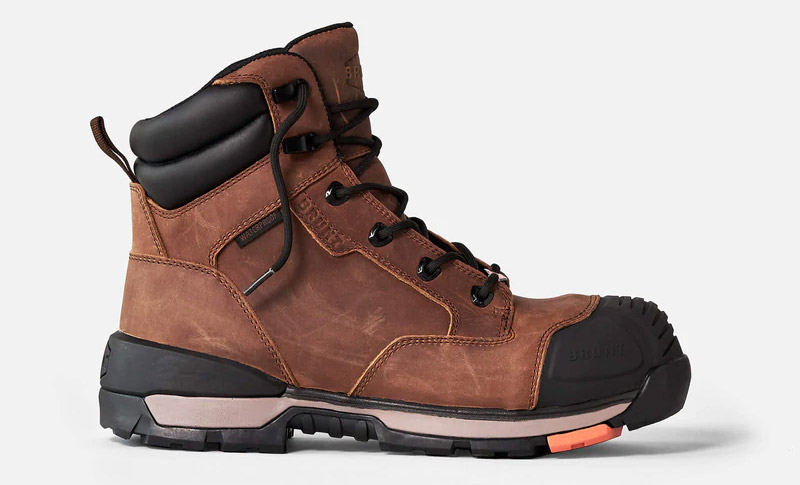
It is important to take the time to measure the length and width of your foot carefully in order to choose a slip-on work boot that fits properly and comfortably. Here are the steps for taking accurate measurements:
- Stand up with your foot flat on a piece of paper or card stock on an even surface. 2. Trace around your foot in its usual stance while standing, making sure not to move your foot while tracing. 3. Using a ruler or measuring tape, measure the distance between your big toe and heel and note the measurements; this is your length measurement.
- Technique 1: Measure across the ball of the foot at its widest point, which should be just above mid-foot area; this is your width measurement (A).
- Technique 2: Draw straight lines inside each side of the traced outline connecting both ends at a point close to where you measured for length; this will form two triangles inside either side of the outlined tracing (as shown in diagram below). Measure from tip of triangle to tip of triangle on either side; this will give you dimension B from diagram below plus any portion outside each triangle (C & D) will equal width A from earlier step 4 above; these dimensions combined equal total width A Steps for Measuring (A+B+C+D=Widest Part A).
6 . Make sure you repeat this process for both feet, as our feet often differ in size slightly from one another! Note all three measurements; length, plus two widths (relative A & B) on paper before shopping online or going into store so you have measurements ready when required by retailer or manufacturer website when purchasing your new slip-on work boots!
Conclusion
Choosing the right pair of work boots can be a daunting and overwhelming experience because there are so many factors to consider. Customers need to keep in mind the type of job they’ll be doing, the environment they will be working in and finally their personal comfort when conducting their specialized boot research.
Keep in mind that slip-on work boots have several standout features, such as an easy slip-on style design which makes them more comfortable than steel toe boots, along with lightweight construction which offers better mobility. As well, these shoes offer all weather construction so workers don’t need to worry about snow and rain getting inside.
Finally, always remember that finding a shoe that meets the condition, size and performance standards for your workplace will depend on personal preference. Investing time in doing a thorough research about work slip-on boots is crucial, as it allows customers to make an informed decision.
FAQs
How are slip on boots supposed to fit?
Slip-on boots should fit snugly but not be too tight. They should be easy to slip on but should not slip off your feet when walking. The heel should fit comfortably without any slipping.
What is the best slip on work boot?
The best slip-on work boot depends on the individual’s needs and preferences. Some popular brands include Red Wing, Timberland Pro, Wolverine, and Ariat. It is important to choose a slip-on work boot that provides adequate protection, comfort, and support for the job.
How do I choose the right work boot?
When choosing a work boot, consider factors such as the type of work you will be doing, the environment you will be working in, and your personal preferences. Look for boots that provide adequate protection, support, and comfort. It is also important to choose boots that fit well and are durable.
How do you know if your slip on boots are too big?
If your slip-on boots are too big, they may slip off your feet when walking or cause blisters and discomfort. You may also notice that your feet slide around inside the boots or that there is extra space between your toes and the end of the boots.
Is it better for boots to be tighter or looser?
Boots should fit snugly but not be too tight. They should be comfortable to wear and allow room for your feet to breathe. Boots that are too tight can cause discomfort and lead to blisters, while boots that are too loose can cause slipping and rubbing.
Should slip on boots be loose in the heel?
No, slip-on boots should not be loose in the heel. The heel should fit snugly and provide support to prevent slipping and rubbing. If the boots are loose in the heel, they may cause discomfort and blisters.
Should you buy boots a size bigger?
It is not recommended to buy boots a size bigger unless you plan to wear thick socks or inserts. Boots that are too big can cause slipping and rubbing, while boots that are too small can cause discomfort and pain.
Do you size down for slip on shoes?
It depends on the brand and style of the slip-on shoes. Some slip-on shoes may run large, while others may run small. It is important to try on slip-on shoes and choose the size that fits snugly and comfortably.
How do you choose slip resistant shoes?
When choosing slip-resistant shoes, look for shoes that have a rubber sole with good traction. Shoes with deep treads or a patterned sole can provide extra grip on slippery surfaces. It is also important to choose shoes that fit well and provide adequate support.
Are slip-on boots good for walking?
Slip-on boots can be good for walking if they fit well and provide adequate support and comfort. It is important to choose slip-on boots with a sturdy sole and good traction for walking on different surfaces.
See Also:
- Best work boots for construction workers 2023
- Best work boots for diabetics 2023
- Best work boots for electricians 2023
- Best work boots for farmers 2023
- Best work boots for flat feet 2023
